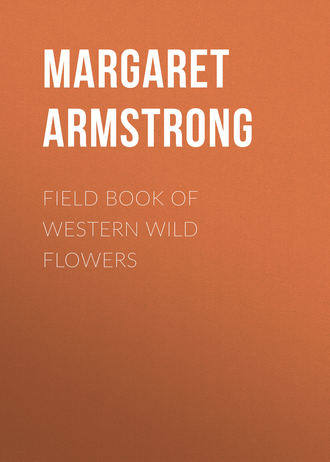 полная версия
полная версияField Book of Western Wild Flowers
Saxifrage
Micránthesrhomboídea (Saxifraga)
White
Spring, summer
Southwest, Idaho, Utah, Col.
A little alpine plant, growing in moist soil, or on mossy rocks. The sticky-hairy flower-stem is from two to twelve inches tall, springing from a cluster of dull-green root-leaves, toothless, or toothed towards the ends, slightly thickish and very slightly downy and the flowers are small, and form a compact cluster.
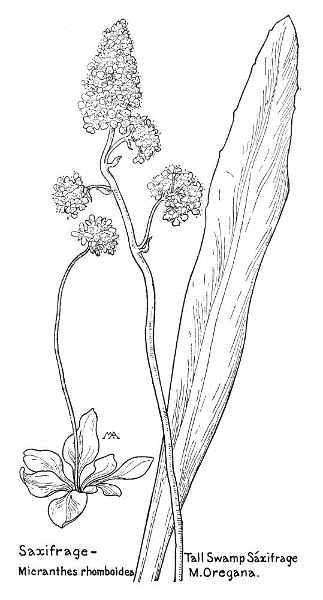
Saxifrage – Micranthes rhomboidea.
Tall Swamp Sáxifrage – M. Oregana.
Modesty
Whípplea modésta
White
Spring
Wash., Oreg., Cal.
The only kind, a pretty little under-shrub, with many woody stems, spreading and trailing on the ground, the branches clothed with more or less hairy leaves, with three veins, and bearing clusters of very small flowers, with a pleasant honey-like fragrance. They usually have ten stamens, the ovary is partially inferior, with from three to five styles; sepals whitish; petals white, becoming greenish. The low masses of green foliage, spotted with white flower clusters, are a pretty feature of the Coast Range forests and thickets, especially among redwoods.
There are several kinds of Mitella, perennials, of North America and Asia.
Bishop's Cap, Mitrewort
Mitélla ovális
White
Summer Northwest and Utah
An inconspicuous little plant, of mountain woods, with pretty leaves and tiny flowers. The slender, hairy, leafless stem, about ten inches tall, springs from a cluster of root-leaves, smooth on the upper side, except for a few bristly hairs, with bristly hairs on the under veins and on the long, slender leaf-stalks. The flowers grow in a graceful, one-sided spray and have a five-lobed, green calyx, five minute petals, five stamens with short filaments, and a roundish ovary, almost wholly inferior. The petals have pretty little bits of feathery fringe between them, which make the little flowers look like tiny snow crystals in shape, when we examine them closely.
There are several kinds of Spatularia, perennials, sometimes with bulblets; leaves from the root, mostly toothed; flowers white, in open clusters; sepals five; petals all clawed, the three upper differing from the two lower; ovary chiefly superior.
Spatulària Brunoniàna (Saxifraga Nutkana) (Saxifraga Bongardi)
White
Summer
Northwest
A beautiful plant, with such slender stems and branches that, at a distance, the little white flowers look like specks of foam. The hairy, reddish stems, from a few inches to over a foot tall and very branching, spring from clusters of thickish, stiffish, hairy root-leaves and bear dozens of flowers, about three-eighths of an inch across, with white petals, spotted with yellow or red at the base and slightly irregular, the three upper petals being narrower than the two lower. The anthers are orange; ovary white or pinkish; calyxes and buds purplish-red. This grows among rocks in mountains.
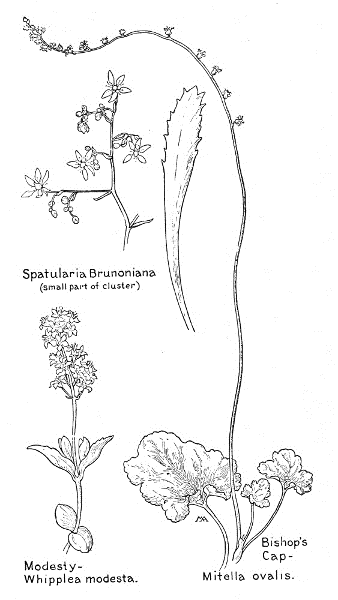
Spatularia Brunoniana (small part of cluster).
Modesty – Whipplea modesta.
Bishop's Cap – Mitella ovalis.
HYDRANGEA FAMILY. Hydrangeaceae
Shrubs or trees, with opposite leaves and no stipules. The flowers are in clusters and usually perfect, but sometimes those at the margins of the clusters are without pistils or stamens and larger than those in the middle; the calyx usually with four to ten sepals, and in sterile flowers often conspicuously enlarged; the petals four to ten; the stamens eight to many; the ovary wholly or partly inferior; the styles separate or united, sometimes lacking; the fruit a capsule. Many very ornamental garden shrubs, such as Deutzia and Hydrangea, are included in this family.
There are several kinds of Fendlera, natives of North America; shrubs, with white or pink flowers, with four sepals and four petals, the latter with claws. The eight stamens have two-forked filaments and the ovary is partly inferior, with four styles.
Féndlera rupícola
White, pink
Spring
Ariz., Utah, Nev.
Among the many beautiful plants to be found in the Grand Canyon one of the most conspicuous is the Fendlera. It is a tall, handsome shrub, growing along the upper part of Bright Angel trail, and in May it is covered with charming white blossoms. These flowers measure an inch across, and have cream-white or pale pink petals, narrowing to a claw at the base, and purplish sepals, and they grow in clusters of three or four, mixed with pink buds, on the ends of short branches. The small oblong leaves have three nerves and the wood is tough and gray, with deeply furrowed bark. Though their scent is rather unpleasant, the flowers are lovely and look just like some novel variety of fruit-blossom, but this resemblance is deceptive for they produce nothing but dry pods.
There are a good many kinds of Philadelphus, natives of North America, Asia, and Europe; shrubs, with large, white or cream-colored flowers; the calyx top-shaped, with four or five lobes; the petals four or five; the stamens twenty to forty, inserted on a disk; the ovary inferior, with three to five styles; the capsule top-shaped, containing many oblong seeds. These plants were named in honor of King Ptolemy Philadelphus. They are often called Mock-Orange, because the flowers often resemble orange-blossoms. The commonest name, Syringa, is confusing, because that is the generic name of the Lilac.
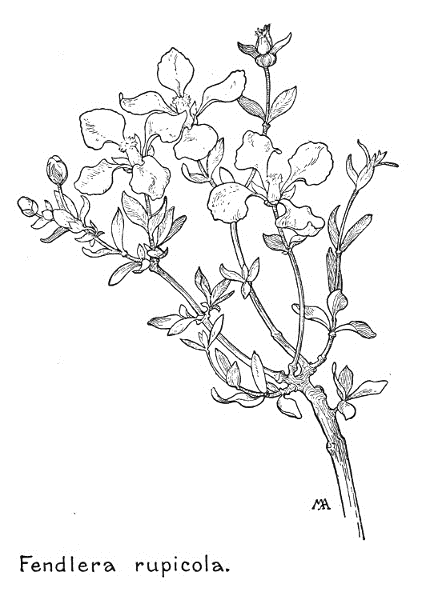
Fendlera rupicola.

Syringa
Philadélphus Califórnicus
White
Summer
Cal., Oreg., Wash.
In June and July, in the high Sierras, up to an altitude of four thousand feet, this lovely shrub forms fragrant thickets of bloom. It looks very much like the familiar garden Syringa and the smell is just as delicious. The bush is from four to twelve feet high, with smooth, pale, woody stems, dark-green leaves, sometimes slightly toothed, very smooth and shiny, and pretty flowers, in clusters at the ends of the branches. They are each about an inch across, with four or five, cream-white petals, rolled in the bud, and a golden center, composed of numerous, bright-yellow stamens.
Small Syringa
Philadélphus microphýllus
White
Summer
Ariz., Cal., New Mex.
A small shrub, not nearly so handsome as the last, from two to three feet high, with slender, pale-gray, woody stems, branching very abruptly. The small leaves are smooth and very bright green on the upper side, but the under side is very pale and covered with close white down. The flowers are much smaller than the garden Syringa, with white petals and numerous yellow stamens, the calyx reddish outside and downy within, and have a delicious smell, like lemon-blossoms. This pretty little shrub may be found growing in small shady canyons, in northern Arizona and elsewhere in the Southwest.

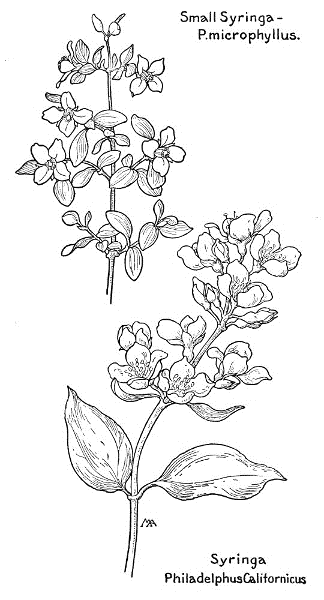
Small Syringa – P. microphyllus.
Syringa Philadelphus Californicus.
GOOSEBERRY FAMILY. Grossulariaceae
A small family, shrubs, with alternate, palmately-lobed leaves, often sticky or resinous; the flowers almost always in clusters; the pedicels with a bract at the base and usually with two bractlets halfway up; petals five, or rarely four, usually smaller than the calyx-lobes; stamens of the same number as the petals and alternate with them; ovary inferior, with two styles, more or less united; fruit a berry, crowned with the withered remains of the flower.
There are several kinds of Grossularia, or Gooseberry; shrubs, sometimes with trailing branches, almost always spiny; flowers with bracts; ovary often spiny.
Wild Gooseberry
Grossulària Roèzli (Ribes)
Maroon and white
Spring
California
This is a stout shrub, one to four feet high, with thick, short, rigid little branches, the knobby joints more or less spiny. The roundish leaves, less than an inch across, are lobed and scalloped, rather dull green and slightly downy, and the flowers are about half an inch long, with maroon-colored sepals and white petals, the base of the calyx-tube downy. The purple berry is half an inch in diameter and covered with stout prickles. This Gooseberry is common at moderate altitudes. The drooping, red and white flowers resemble tiny Fuchsias, both in color and form. G. Menzièsii, the Canyon Gooseberry, also has pretty fuchsia-like flowers and grows in the Coast Ranges of California and Oregon, blooming in the winter.
Fuchsia-flowered Gooseberry
Grossulària speciòsa
Red
Spring
California
In spite of its name, the flowers of this handsome shrub do not look as much like Fuchsias as the two last. The stems are armed with long thorns and the leaves are thick, dark green, and glossy. The flowers have four sepals, four petals, and four stamens and are about an inch long and beautiful bright-red in color. The berry is dry and very prickly. This is common in the southern part of California.

Fuchsia-flowered Gooseberry – G. speciosa.
Wild Gooseberry – Grossularia Roezli.
There are many kinds of Ribes, or Currant, of temperate regions; shrubs, almost always smooth; flowers sometimes blooming before the leaves, with five petals, smaller than the five calyx-lobes, which are often colored; stamens five; ovary inferior, fruit a smooth, many-seeded berry. In general the low shrubs, with their pretty foliage, may be recognized by their resemblance to cultivated kinds. Ribes is the ancient Arabic name.
Black Currant
Rìbes Hudsoniànum
White
Spring, summer
Utah, Wash., Idaho, etc.
Except that its foliage has a strong disagreeable smell, this is an attractive shrub, three to six feet high, with pale gray, woody stems, without thorns, and smooth, bright green leaves, five-lobed and thin in texture, paler on the under side, with resinous dots and broad, papery stipules, in clusters, with reddish bracts at the base. The flowers form close, erect clusters, less than two inches long, springing from the same bud as the leaves; the calyx, which is the conspicuous part, cream-white, greenish in the center; the petals very small and white. The berry is smooth or hairy, round and black, without "bloom," and possibly edible, but so bad-smelling as to be avoided. This grows beside mountain streams and is found as far north as British Columbia.
Sierra Currant
Rìbes Nevadénse
Pink
Summer
Cal., Oreg., Wash., Nev.
A thrifty, mountain bush, from three to six feet high, the upper stems pale gray and the lower ones reddish; the leaves thin and smooth, prettily scalloped and lobed, often with a few white hairs at the base of the leaf-stalks. The flowers are fragrant and pink, over half an inch long, and form a close cluster, of eight or more. The berry is black, with a white "bloom," and tastes sweet and insipid. This reaches an altitude of eight thousand feet. Rìbes glutinòsum is called Incense-shrub, because of its strong fragrance. It is a large handsome shrub, sometimes fifteen feet high, with beautiful drooping clusters of gay pink flowers. The leaves are sticky when they first come out and the berry is blue, with a dense "bloom," bristly, dry and bitter, or insipid. This blooms in winter or early spring and is common in canyons near the coast.
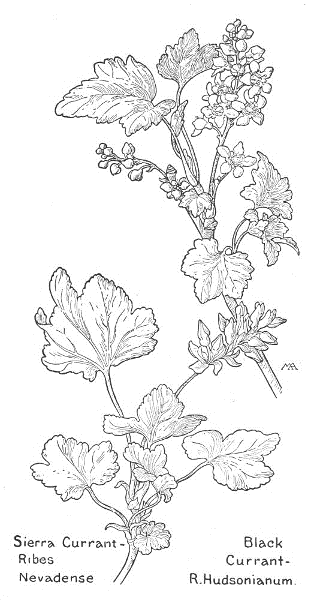
Sierra Currant – Ribes Nevadense.
Black Currant – R. Hudsonianum.
Golden, Missourior Buffalo Currant
Rìbes àureum
Yellow
Spring, summer
West, etc.
A very handsome bush, from five to twelve feet high, with pretty foliage and smooth, pinkish-gray, woody stems. The bright green leaves, with three or five lobes, are thin in texture, with a few hairs on the leaf-stalks, fresh and glossy-looking, and setting off the bright clusters of clear yellow flowers, of which the calyx, half an inch across, with a long greenish-yellow tube, is the conspicuous part. The small petals are sometimes yellow, but often bright red and the fruit is smooth, yellow, red, or black, and edible. This is deliciously fragrant and spicy, very handsome and attractive, growing beside brooks and in moist canyons, where sometimes, in masses, it has at a distance the effect of Forsythia, but purer in color. It grows as far east as Missouri and is often cultivated.
APPLE FAMILY. Pomaceae
A rather large family, widely distributed, including many attractive trees and shrubs, such as Mountain Ash and Hawthorn, as well as Pears and Apples, with pretty blossoms and conspicuous, often edible fruits; leaves alternate; stipules small; flowers regular, perfect, single or in clusters; calyx usually five-toothed or five-lobed; petals mostly five, usually with claws; stamens numerous, or rarely few, separate, with small anthers; ovary inferior and compound; styles one to five. The calyx-tube gradually thickens and becomes a "pome," or apple-like fruit, in which the core is the ovary.
There are several kinds of Amelanchier, of the north temperate zone; shrubs or trees, with thornless branches and white flowers, usually in clusters; calyx-tube bell-shaped, with five narrow sepals; petals five; stamens numerous, on the throat of the calyx; styles two to five in number, united and hairy at base; ovary wholly or partly inferior; fruit small and berry-like. The name is from the French for the Medlar. These shrubs are called Shadbush in the East, because they bloom just when the shad are beginning to run in the rivers.
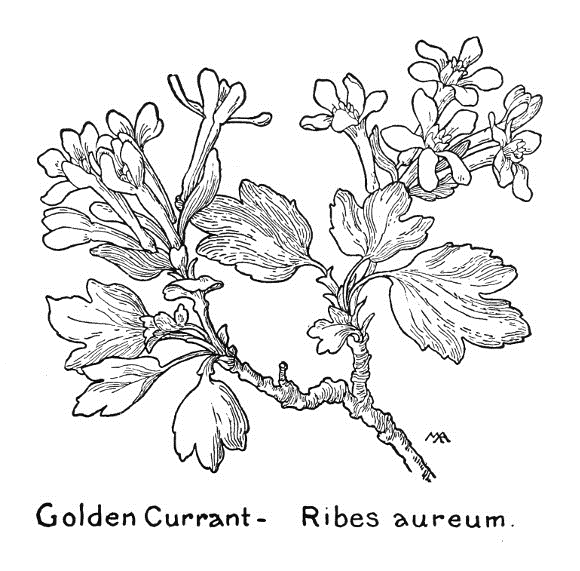
Golden Currant – Ribes aureum.
Service-berry, June-berry
Amelánchier alnifòlia
White
Spring, summer
West, etc.
A pretty shrub with woody, branching stems, reddish twigs and smooth, bright green leaves, sometimes downy on the under side, toothed only at the ends. The flowers, less than an inch across, have long, narrow, straggling petals, and are so mixed with leaves, and crowded so irregularly on the branches, that the effect is rather ragged. The roundish, pulpy, black fruit is liked by the Indians, but though sweet is insipid. When thickets of this shrub are in bloom on mountainsides the effect is very pretty, especially in Utah, where the shrubs are more compact and the flowers less straggling than in Yosemite, giving at a distance much the effect of Hawthorn. It grows as far east as Nebraska and in British Columbia.
PLUM FAMILY. Drupaceae
A rather small family, widely distributed, trees or shrubs, the bark exuding gum, the foliage, bark, and seeds bitter, containing prussic acid; leaves alternate, toothed, with leaf-stalks; stipules small; flowers mostly perfect, regular, single or in clusters; calyx five-lobed, dropping off after flowering; petals five, inserted on the calyx; stamens numerous, inserted with the petals; pistil one in our genera; ovary superior, developing into a stone-fruit.
There are many kinds of Prunus, including Cherry as well as Plum, with white or pink flowers and usually edible fruits. Prunus is the ancient Latin name for plum.
Holly-leaved Cherry, Islay
Prùnus ilicifòlia
White
Summer
California
Mountain slopes near Santa Barbara are beautiful in June with the creamy flowers of this very ornamental evergreen shrub, from five to twenty-five feet high, with shiny, leathery, dark green leaves, with prickly edges, looking much like Holly. The small flowers form close but feathery clusters, from one to three inches long, and smell pleasantly of honey. The sweetish fruit, not particularly good to eat, is a dark red cherry, about half an inch in diameter. In dry places these shrubs are small, but in favorable situations, such as the old mission gardens, where they have been growing for perhaps a hundred years, they develop into small trees.
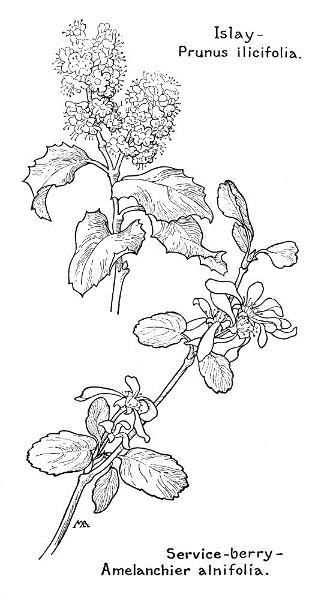
Islay – Prunus ilicifolia.
Service-berry – Amelanchier alnifolia.
ROSE FAMILY. Rosaceae
A large and important family, widely distributed and including some of our loveliest flowers and most delicious fruits; herbs, shrubs, or trees; generally with stipules and usually with alternate leaves; the flowers rich in pollen and honey and usually perfect. The calyx usually five-lobed, often with bracts, with a disk adhering to its base; the petals of the same number as the calyx-lobes, separate or none; the stamens usually numerous, separate, with small anthers; the ovary superior, or partly inferior; the pistils few or many, separate or adhering to the calyx, sometimes, as in the true Rose, enclosed and concealed in a hollow receptacle; the fruit of various kinds and shapes.
There are several kinds of Opulaster, branching shrubs, with clusters of white flowers and grayish or reddish, shreddy bark.
Ninebark
Opuláster malvàceus
(Physocarpus)
White
Summer
Northwest, Utah, Ariz.
This is a handsome bush, from three to six feet high, with pretty, almost smooth, bright green leaves, with large stipules. The flowers are sweet-smelling, about half an inch across, with cream-white petals, and form very beautiful and conspicuous rounded clusters, about three inches across, the long stamens giving a very feathery appearance. At a distance this shrub has the effect of Hawthorn in the landscape. It grows on mountainsides in rich soil.
Apache Plume
Fallùgia paradóxa
White
Spring
Ariz., New Mex.
There are two kinds of Fallugia. This is usually a low undershrub, but in the Grand Canyon, on the plateau, it is a fine bush, four or five feet high, with pale woody, branching stems; the small, somewhat downy, evergreen leaves, resembling those of the Cliff Rose, but the flowers larger. They are white, two inches across, like a Wild Rose in shape, with beautiful golden centers, and grow on long, slender, downy flower-stalks, at the ends of the branches. Individually, they are handsomer than the flowers of the Cliff Rose, but not nearly so effective, as the bloom is much more scattered. The calyx-tube is downy inside and the five sepals alternate with five, small, long, narrow bractlets. The hairy pistils are on a small conical receptacle, surrounded by a triple row of very numerous stamens on the margin of the calyx-tube.
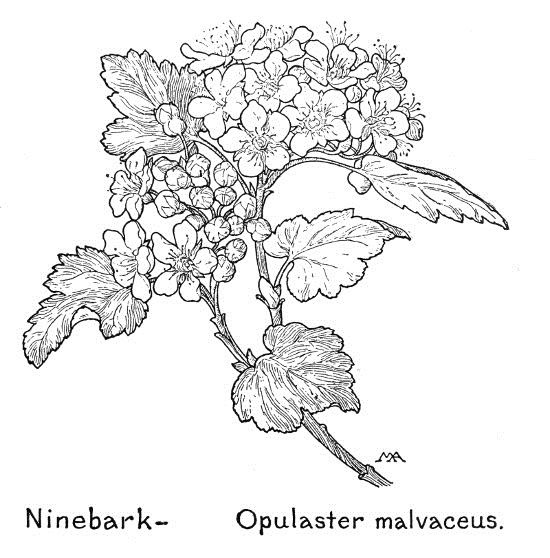
Ninebark – Opulaster malvaceus.
Wild Roses are widely distributed in the northern hemisphere and are too familiar to need much description. There are numerous kinds; some are climbing, all are prickly and thorny, with handsome, often fragrant, flowers and compound leaves, with toothed edges. The numerous yellow stamens are on the thick margin of a silky disk, which nearly closes the mouth of the calyx. The numerous pistils develop into akenes, or small, dry, one-seeded fruits. These look like seeds and we find them inside the calyx-tube, which in ripening enlarges and becomes round or urn-shaped. These swollen calyx-tubes are the "hips," which turn scarlet and add so much to the beauty of the rose-bush when the flowers are gone. Rosa is the ancient Latin name.
Fendler's Rose
Ròsa Féndleri
Pink
Spring, summer
Idaho, Utah, Ariz.
This is a very handsome thrifty bush, about four feet high, with smooth, or slightly downy, bright green leaves, and thorny stems, with slightly curved thorns. The flowers are more or less fragrant and about two inches across, with bright pink petals, which gradually become paler as they fade, and pretty crimson-tipped buds. This has smooth "hips" and is a beautiful and conspicuous kind, growing in valleys and along streams, up to an altitude of nine thousand feet. It is widely distributed and variable, probably including several forms.
California Wild Rose
Ròsa Califórnica
Pink
Spring, summer, autumn
Cal., Oreg.
A large bush, three to six feet high, with erect, branching stems, armed with a few, stout thorns, which turn back. The leaves are more or less downy, especially on the under side, with from three to seven leaflets, and the flowers usually form a cluster of few or many and are each from one to nearly two inches across, with pale pink petals. They are lovely flowers, with a delicious fragrance, and are common at low and moderate altitudes in California, usually growing near streams.
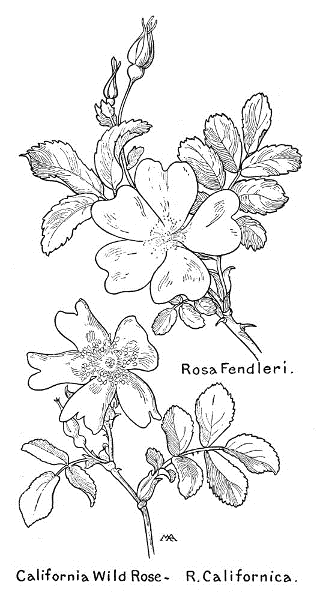
Rosa Fendleri.
California Wild Rose – R. Californíca.
Redwood Rose
Ròsa gymnocàrpa
Pink
Spring, summer
Northwest
A charming kind, delicate both in foliage and flower, usually growing in shady, mountain woods. The slender bush is from one to three feet high, with dark brown stems, armed with some straight, slender thorns, and light green leaves, usually with quite a number of neat little leaflets, smooth and thin in texture. The flowers are an inch or less across, usually single, with light yellow centers and bright pink petals, very clean and fresh in tone, usually deeper towards the margins. The sepals are not leafy at the tips, the flower-stalks, and sometimes the leaf-stalks also, are covered with small, dark, sticky hairs and the buds are tipped with carmine. Neither leaves nor flowers are fragrant.
Mountain Misery
Chamaebàtia foliolòsa
White
Summer
California
This is the only kind. In open places, in the Sierra forests, the ground is often carpeted for acres with the feathery foliage of this charming shrub, sprinkled all over with pretty white flowers. Mountain Misery does not at first seem an appropriate name for so attractive a plant, but when we walk through the low, green thickets we find not only that the tangled branches catch our feet but that the whole plant is covered with a strong-smelling, resinous substance, which comes off on our clothes in a most disagreeable manner. On a warm day the forest is filled with the peculiar, medicinal fragrance and when, later in the season, we unpack our camping outfit we are apt to be puzzled by the smell of "Pond's Extract" which our clothes exhale. The shrub is usually less than two feet high, with downy, evergreen foliage, the numerous small leaflets so minutely subdivided and scalloped that they have the appearance of soft ferns. The flowers resemble large strawberry-blossoms, and have a top-shaped, five-lobed calyx, many yellow stamens and one pistil, becoming a large, leathery akene. The smell and foliage attract attention and the shrub has many names, such as Bear-mat and Kittikit, or Kit-kit-dizze, so-called by the Indians. Bears do not eat it, so the name Bear-clover is poor, and Tarweed belongs to another plant. It is used medicinally.

